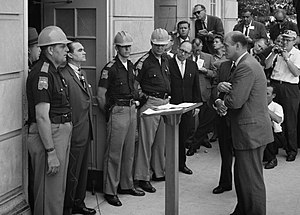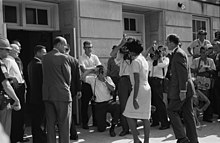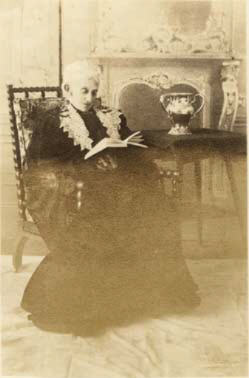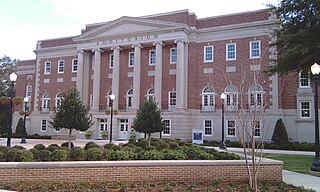This article needs additional citations for verification .(December 2007) |

The University of Alabama, the state's oldest continuously public university, is a senior comprehensive doctoral-level institution located in Tuscaloosa, Alabama.
This article needs additional citations for verification .(December 2007) |

The University of Alabama, the state's oldest continuously public university, is a senior comprehensive doctoral-level institution located in Tuscaloosa, Alabama.
The History of The University of Alabama begins with an act of United States Congress in 1818 authorizing the newly formed Alabama Territory to set aside a township for the establishment of a "seminary of learning." Alabama was admitted to the Union on March 20, 1819, and a second township added to the land grant. [1] The seminary was established by the General Assembly on December 18, 1820, and named The University of the State of Alabama . The legislature appointed a board of trustees to handle the building and opening of the campus, and its operation once complete. [2] The Board selected Tuscaloosa, then capital of Alabama, as the site of the university in 1827, and opened its doors to students on April 18, 1831. The land had been owned by William Marr, [3] whose name is commemorated today in Marrs Spring and the literary Marrs Field Journal. A prominent architect, Captain William Nichols, was commissioned to design the campus. An extensive vineyard was situated in the area of Denny Field and Barnwell Hall.
Most of the material for the early buildings came from university land. Sandstone was quarried near the Black Warrior River, bricks were made locally and lumber came from the University's own timber tract. The work was hard and done by hand, and the University depended on the toil of enslaved workers. "Slaves made the bricks that went into buildings, they worked the grounds and buildings around the campus. They carried water, serviced the dormitories, worked in the dining halls." [4] According to James Sellers' History of the University of Alabama, "Much of the labor was, of course, performed by slaves" but also noted "the stonemasons, trained artisans of Scotch descent, built their pride of craft into the strength and beauty of the buildings they helped erect. [5]
The board of trustees selected the Reverend Alva A. Woods to be the first president of the university. Educated at Phillips Andover, Harvard College and in Europe, Woods hoped to turn the university into a Harvard-style seminary. [6] This proved impossible. Though highly gifted, Woods was not equipped to deal with the discipline problems that came with young men from the frontier. [7]
Admission standards were set high. Simply to enter the university, one had to demonstrate the ability to read Classical Greek and Latin at an intermediate level, with advanced study in those languages to begin immediately. But Alabama, a frontier state a sizable amount of whose territory was still under the control of various Native American tribes, was decades away from possessing the infrastructure necessary to provide adequate education (public or even private) to meet such high standards.
The university was consequently forced to admit many students who were not adequately prepared for university education. For the duration of the Antebellum period, the university would graduate only a fraction of those young men who entered. Of the 105 students who enrolled in 1835, only eight graduated.
Within a month of the opening of the university, social societies emerged. Unlike the social fraternities that would emerge in the next decade, these clubs were academic debate societies by nature. The Erosophic Society was founded in May 1831, while the Philomathic Society came out eight months later.
For $80 a year, students received room and board at the Hotel, now known as the Gorgas House. Washington Hall and Jefferson Hall, called the "colleges," stood three stories high. Each contained twelve apartments, which in turn contained two bedrooms and a sitting room. Forty-eight students resided in each dormitory. Madison and Franklin Halls were built later. Following the American Civil War, the remains of Madison and Franklin Halls were made into memorial mounds. Madison Mound was removed during the 1920s, but Franklin Mound is still used for Honors Day ceremonies. Additionally, an archaeological excavation, conducted in 2007, examined the remains of Washington and Jefferson Halls foundations.
At the center of the campus, where the Gorgas Library is now situated, stood the "grande dame" of the university, the Rotunda. In the 1894 yearbook, Corolla, the building is described as "a circular edifice of three stories, seventy feet in diameter and seventy feet in height, and surrounded by a lofty peristyle of the Ionic order of architecture. The principal story was used for chapel service and academic recitations. This department was long celebrated as being the finest auditorium in the State. In the second story was the circular gallery, supported by carved columns of the Corinthian order. The third story contained the library and the collections in natural history." The Rotunda was destroyed by fire and was never rebuilt. Following an excavation in 1985, the Rotunda's remains were cushioned in sand and covered with concrete to mark where the building had once stood.
Greek life began at the university in 1847 when two young Mobilians visiting from Yale installed a chapter of Delta Kappa Epsilon. When DKE members began holding secret meetings in the old state capitol building that year, the administration strongly voiced its disapproval. Over the next decade, four other fraternities appeared at Alabama: Alpha Delta Phi in 1851, Phi Gamma Delta in 1855, Sigma Alpha Epsilon in 1856, and Kappa Sigma in 1857. Anti-fraternity laws were imposed in that year, but were lifted in 1890s. Eager to have a social organization of their own, women at the university founded the Zeta chapter of Kappa Delta sorority in 1903. Alpha Gamma Delta and Delta Delta Delta soon followed.

Student discipline remained a struggle. [8] In the 1850s, the school's president, Landon Garland, began lobbying the Legislature to transform the university into a military school. In 1860, with the Civil War impending and in the wake of a violent brawl which resulted in the death of student, the legislature authorized Garland to make the transformation beginning in the fall of 1860. As a result of this transformation, during the Civil War, the school trained officers for the Confederacy.
Because of this role, Union troops burned down the campus in April 1865. Only seven buildings survived the burning, one of which was the President's Mansion and its outbuildings. Frances Louisa Garland, wife of President Landon C. Garland, saved the home from destruction by the Union soldiers. When she saw flames in the direction of the campus, she ran from the Bryce home where the family had taken refuge and demanded the soldiers put out the fire in the parlor. The university reopened in 1871 and shortly after, the military structure was dropped. The other principal buildings today, have new uses. Gorgas House, at different times the dining hall, faculty residence, and campus hotel, now serves as a museum. The Roundhouse, then a sentry box for cadets, later a place for records storage, is a campus historical landmark. The Observatory, now Maxwell Hall, is home to a program called Creative Campus.
In 1880, the United States Congress granted the university 40,000 acres (160 km2) of coal land as partial compensation for the $250,000 in war damages. Some of the money went toward the building of Manly and Clark Halls. In 1887, Clark became the home of the library, whose 7,000 volumes had been destroyed. It was not until 1900 that private donations, including the donation of 1,000 volumes collected by John Leslie Hibbard's father, restored the library to 20,000 books. Garland Hall, which housed the geology museum and lecture rooms, completed what became known as Woods Quad. Tuomey and Barnard Halls were also built before 1900.
The medical school and pharmacy school were in Mobile at the time. [9]
The university was officially opened to women in 1892 after much lobbying by Julia Tutwiler to the Board of Trustees.

In 1900 students fomented rebellion against the military system, leading to the resignations of the student commandant and university president James Knox Powers. In 1903 the state legislature abolished the military system that was proving so unpopular with students.
In celebration of the university's seventy-fifth anniversary in 1906, the Greater University fund-raising campaign began, spearheaded by alumni Hill Ferguson and Robert Jemison. The $5,000 which the campaign secured from the state legislature in 1909 went toward the building of Smith and Morgan Halls. Constructed of yellow Missouri brick with Indiana limestone trim, the buildings reflected the Beaux-Arts Greek Revival style of architecture that was popular at the turn of the 20th century.
The first years of the 20th century, when students had more freedom and the university was more established, saw the addition of a glee club, a drama club, a yearbook, and a student newspaper. One of the top female students, Helen Vickers, wrote the lyrics to UA's first alma mater. Female enrollment increased, and football became a passion.


On January 1, 1912, Dr. George H. "Mike" Denny left the presidency of Washington and Lee University in Virginia to lead The University of Alabama through a period of growth. [10]
In 1939, Amelia Gayle Gorgas Library opened.
Following America's entry into World War II in 1941, UA again became focused on training military members. Under the leadership of Dr. Raymond Ross Paty the university operated one of the largest military programs in the country. [11]
The University Club was converted into a servicemen's center, and female university students were hostesses to military members passing through Tuscaloosa, and to wounded GIs at Northington Hospital. During this time, few male students remained on campus, as enrollment dropped from nearly 5,000 in the fall of 1941 to 1,850 in spring of 1944. Students, faculty and alumni joined the war effort in either the armed forces or in a related civilian capacity.
By the end of the war, about 350 former students and one faculty member had died in combat or from other war-related causes. Of the dead, 13 had played on the Crimson Tide football team. One alumna, Janice Eloise Ford Beckwith, died while serving with the Red Cross in the Pacific. [12]
While housing and educating nearly 13,000 soldiers and sailors created a strain on space and teaching resources, the university also grew in the areas of research, library facilities, and benefits for faculty and staff. The University of Alabama Press was founded, the medical school moved to Mobile, and the University Club was transferred to UA ownership. Dr. Paty resigned in December 1946, having led The University of Alabama through one of the hardest times in the history not just of UA, but of the nation.

In 1953, Autherine Lucy sued in Lucy v. Adams to prevent the university from denying admission solely based on race or color. Lucy became the first African-American to attend the school when she was admitted in 1956. On the third day of classes, a hostile mob assembled to prevent Lucy from attending classes. The police were called to secure her admission but, that evening, the University suspended Lucy on the grounds that it could not provide a safe environment. The university overturned her expulsion in 1980, and in 1992, Lucy earned her master's degree in elementary education from the university that she was admitted two decades earlier. [13]
On June 11, 1963, Governor George Wallace attempted to prevent desegregation of that institution by blocking two African-American students, Vivian Malone and James Hood, from class registration at the University's Foster Auditorium in the "Stand in the Schoolhouse Door" incident. When confronted by federal marshals, Wallace stepped aside, and allowed them to register for classes. [14]
The University paid tribute to Autherine Lucy, James Hood and Vivian Malone at the dedication of the Malone-Hood Plaza and Autherine Lucy Clock Tower at Foster Auditorium on November 3, 2010. A 40-foot-tall brick tower, with open arches and four large bronze plaques at its base, tells their stories. [15]

Tuscaloosa is a city in and the seat of Tuscaloosa County in west-central Alabama, United States, on the Black Warrior River where the Gulf Coastal and Piedmont plains meet. Alabama's fifth-most populous city. The population was 99,600 at the 2020 census, and was estimated to be 110,602 in 2022. It was known as Tuskaloosa until the early 20th century. It is also known as "the Druid City" because of the numerous water oaks planted in its downtown streets since the 1840s.

The University of Alabama is a public research university in Tuscaloosa, Alabama. Established in 1820 and opened to students in 1831, the University of Alabama is the oldest and largest of the public universities in Alabama as well as the University of Alabama System. It is classified among "R1: Doctoral Universities – Very high research activity".

David Bibb Graves was an American Democratic politician and the 38th governor of Alabama 1927–1931 and 1935–1939, the first Alabama governor to serve two four-year terms. He successfully advanced progressive political programs while allying himself with the Ku Klux Klan, probably serving as head of the Montgomery chapter.

Autherine Juanita Lucy was an American activist who was the first African-American student to attend the University of Alabama, in 1956. Her expulsion from the institution later that year led to the university's President Oliver Carmichael's resignation. Years later, the University admitted her as a master's student and in 2010 a clock tower was erected in her honor on its campus.

The Auburn University Chapel is the second-oldest building and oldest building in its original location on the campus of Auburn University in Auburn, Alabama.

Landon Cabell Garland (1810–1895), an American, was professor of physics and history and university president three times at different Southern Universities while living in the Southern United States for his entire life. He served as the second president of Randolph–Macon College in Ashland, Virginia, from 1836 to 1846; then professor from 1847 to 1855, and then third president of the University of Alabama in Tuscaloosa, Alabama, from 1855 to 1867; and first chancellor of Vanderbilt University in Nashville, Tennessee, from 1875 to 1893. He was an apologist for slavery in the United States before the Civil War, but afterward became a vociferous spokesperson against slavery.

Josiah Gorgas was one of the few Northern-born Confederate generals and was later president of the University of Alabama.

Amelia Gayle Gorgas was librarian and postmaster of the University of Alabama for 25 years until her retirement at the age of eighty in 1907. She expanded the library from 6,000 to 20,000 volumes. The primary library at the university is named after her. A native of Greensboro, Alabama, Amelia was the daughter of Alabama governor John Gayle, the wife of Pennsylvania-born Confederate general Josiah Gorgas and the mother of Surgeon General William C. Gorgas. She was inducted into the Alabama Women's Hall of Fame in 1977.

Foster Auditorium is a multi-purpose facility at the University of Alabama in Tuscaloosa, Alabama. It was built in 1939 as a Works Progress Administration project and has been used for Alabama basketball, women's sports, graduations, lectures, concerts, and other large gatherings, including registration. Its status as the largest indoor building on campus came to an end in 1968 with the opening of the Memorial Coliseum. The building housed the Department of Kinesiology until 2006. In April 2009, the University announced a major renovation for the auditorium. After the renovation, the Crimson Tide women's basketball and volleyball programs moved back to Foster Auditorium, their original home.

The Stand in the Schoolhouse Door took place at Foster Auditorium at the University of Alabama on June 11, 1963. George Wallace, the Governor of Alabama, in a symbolic attempt to keep his inaugural promise of "segregation now, segregation tomorrow, segregation forever" and stop the desegregation of schools, stood at the door of the auditorium as if to block the entry of two African American students: Vivian Malone and James Hood.

The Quad is an approximately 22-acre (8.9 ha) quadrangle on the campus of the University of Alabama located in Tuscaloosa, Alabama. Home to most of the university's original buildings, this portion of the campus remains the geographic and historic center of the modern campus. Originally designed by noted English-born architect William Nichols, construction of the university campus began in 1828, following the move of the Alabama state capital from Cahaba to Tuscaloosa in 1826. The overall design for this early version of the campus was patterned after Thomas Jefferson's plan for the University of Virginia, with its Lawn and Rotunda. Following the destruction of the campus during the American Civil War, a new Quad emerged in the late 19th and early 20th centuries. Different in form and function from the original design of the early 19th century, the modern Quad continues to fill its role as the heart of the campus. Although surrounded by academic and administrative buildings, only five structures are built directly on the Quad: the Little Round House, Tuomey Hall, Oliver-Barnard Hall, Amelia Gayle Gorgas Library, and Denny Chimes. The remainder of the space is occupied by a grove of trees on the west side and a great lawn on the east. A feature on the northwestern side, known as The Mound, is the site of the old Franklin Hall. A popular gathering place, the Quad is home to pep rallies, a bonfire during homecoming, and numerous day-to-day student activities.

The Gorgas–Manly Historic District is a historic district that includes 12 acres (4.9 ha) and eight buildings on the campus of the University of Alabama in Tuscaloosa, Alabama. The buildings represent the university campus as it existed from the establishment of the institution through to the late 19th century. Two buildings included in the district, Gorgas House and the Little Round House, are among only seven structures to have survived the burning of the campus by the Union Army, under the command of Brigadier General John T. Croxton, on April 4, 1865. The other survivors were the President's Mansion and the Old Observatory, plus a few faculty residences.

The President's Mansion is a historic Greek Revival style mansion on the campus of the University of Alabama in Tuscaloosa, Alabama. It has served as the official residence of university presidents ever since its completion in 1841. The structure narrowly avoided destruction during the American Civil War, making it one of the oldest surviving buildings on campus today. The mansion was added to the National Register of Historic Places on January 14, 1972, due to its architectural and historical significance.
The Alabama Women's Hall of Fame honors the achievements of women associated with the U.S. state of Alabama. Established in 1970, the first women were inducted the following year. The museum is located in Bean Hall, a former Carnegie Library, on the campus of Judson College in Marion, Alabama. It became a state agency in 1975 by an act of the Alabama Legislature. The organization is governed by an eleven-member board. They are elected to three-year terms with a minimum of one board member from the fields of art, business, community service, education, law, medicine, politics, religion, and science. In addition to the board, the President of Judson College and Governor of Alabama both serve as voting members.

Frank Anthony Rose was an American academic, formerly a president of the University of Alabama.

Eugene Allen Smith was an American geologist. After serving in the American Civil War, he became the Alabama state geologist in 1873 and president of the Geological Society of America in 1913.

William J. Vaughn was an American university professor, school principal, librarian and book collector. He was one of the earliest professors at the University of Alabama in Tuscaloosa, Alabama, and at Vanderbilt University in Nashville, Tennessee.
Fort Bibb was a stockade fort built in present-day Butler County, Alabama during the First Seminole War.

Chinnabee, also spelled Chinneby or Chinnibee, is an unincorporated community in Talladega County, Alabama, United States.

Fort Dale was a stockade fort built in present-day Butler County, Alabama by Alabama Territory settlers. The fort was constructed in response to Creek Indian attacks on settlers in the surrounding area.